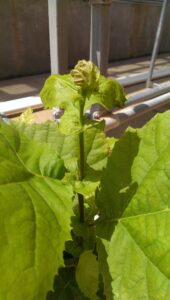A recent conversation with a landscaper about tank mixing led to a brief discussion about glyphosate products with a contact herbicide included. I thought I would share my thoughts on the addition of contact herbicides and its effectiveness on weed control.
We all know that we live in a microwave society. Most people want things immediately. I recall a comedian’s joke several years ago about a baked potato taking so long to cook that he put one in the oven in the morning before work, just in case he wants one for dinner. The immediacy of our society has even evolved into herbicides.
Herbicidal properties determine how long after a herbicide is applied until symptoms are observed. Contact herbicides typically show symptoms relatively fast, sometimes in a couple of hours. Systemic herbicides typically take longer to show symptoms due to their mode of action and sites of action.
Glyphosate is a non-selective, systemic herbicide, meaning it kills most weeds and is translocated throughout the plant via the (primarily) phloem. Glyphosate’s site of action is located in the shikimic acid pathway, which leads to many secondary metabolites, such as lignin and tannin. Since glyphosate works on the secondary metabolism (aka non-photosynthesis/making of carbohydrates), symptoms won’t be evident until 8-10 days after treatment. Since it’s one of the slower acting herbicides, some companies began to add a contact herbicide to increase herbicide phytotoxicity quicker than stand-alone glyphosate.
- Figure 1. Glyphosate damage to sycamore after five days.
This leaves us in a kind of quandary. For systemic herbicides to be most effective, the weeds need to be actively growing. The more active the growth, the more translocation of the herbicide occurs.
Adding a contact herbicide to glyphosate will injure the weed before much of the translocation occurs with the systemic nature of glyphosate. In a 2008 study, it was found that glyphosate-based, ready-to-use products with diquat, weeds showed symptoms soon after application, but long-term weed control efficacy with glyphosate alone was improved over time. The diquat reduced the translocation of the glyphosate, thus didn’t work as effectively as compared to glyphosate alone. The study also indicated that an increase of 60% of glyphosate would be needed to counteract the antagonistic effect of the diquat (Wehtje, et.al. 2008).
In some situations, a glyphosate product with a contact herbicide included will be needed if a quick burndown is the goal. In most cases, omitting the contact herbicide will increase the efficacy of the product and result in more effective weed control.
References:
Wehtje, G., Atland, J.E., and Gilliam, C.H. 2008. Interaction of Glyphosate and Diquat in Ready-to-Use Weed Control Products. Weed Technology. Volume 22. Issue 3. Pp.472-476.
